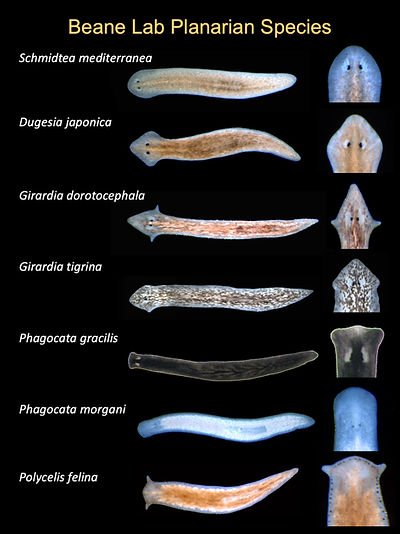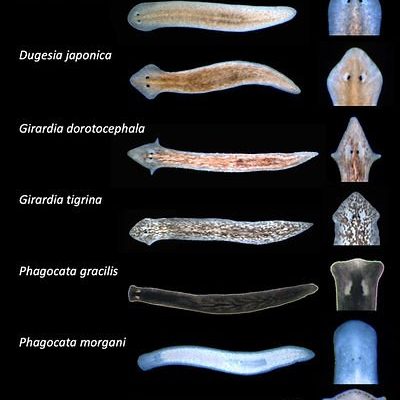
Planaria are a type of flatworm known for their remarkable ability to regenerate – they can grow back parts of their bodies if they get cut! That’s like getting a second chance at a broken toy. In their watery habitats like ponds or streams, they share space with other creatures, some of which might seem like distant relatives. Understanding what sets planaria apart from these similar species can give us a clearer picture of their role in the ecosystem and what makes them so intriguing. So, grab a cup of coffee, and let’s explore!
What Are Planaria?
Planaria are flatworms that belong to the class Turbellaria. These fascinating organisms can often be found swimming gracefully in freshwater environments. They come in various shapes and colors, but the most common ones are typically flat and have a soft, elongated body. Planaria are not just ordinary worms; they are known for their incredible regenerative abilities. This means that if a planarian loses a part of its body, it can regrow it, which makes them a hot topic in scientific research.
These tiny creatures have a unique feature: they possess a simple nervous system with two eye spots that can sense light. Imagine them as little swimming sensors, detecting the world around them. They primarily feed on bacteria, tiny bits of organic material, and small invertebrates. This diet allows them to thrive in various freshwater habitats, contributing to the ecosystem by helping to break down organic matter.
But what makes planaria truly captivating is their regenerative capacity. If a planarian gets cut in half, both halves can regenerate into whole worms! This has fascinated scientists for years and opens up discussions about cellular regeneration and healing.
Planaria vs. Other Flatworms
While planaria are well-known, they are just one type of flatworm. There are various other flatworm species, such as trematodes and cestodes. Trematodes, or flukes, often live inside a host organism and can be parasites. Unlike planaria, which thrive in open waters, trematodes have a more complex life cycle and can affect the health of their hosts.
On the other hand, cestodes, or tapeworms, are another group of flatworms that can cause trouble for their hosts. These worms live in the intestines of animals, including humans, absorbing nutrients from the food their hosts eat. While planaria are mostly harmless and play a role in their ecosystems, the other types of flatworms can be detrimental, causing diseases and health issues.
So, what sets planaria apart? It’s their lifestyle – they are free-living creatures that hunt for food and regenerate, while other flatworms often rely on hosts for survival. This lifestyle difference highlights the diverse strategies these worms employ to thrive in their respective environments.
Habitats of Planaria and Similar Species
Planaria typically thrive in freshwater habitats like ponds, lakes, and streams. They enjoy environments rich in organic matter, where they can easily find food. Think of them as little scavengers, seeking out the nutrients they need to survive. The presence of decaying leaves and algae creates the perfect buffet for these worms.
In contrast, trematodes often inhabit the bodies of mollusks or fish as part of their life cycles. They might be found in the same waters as planaria, but their lifestyle is much different. Cestodes, too, can be found in aquatic environments, but they ultimately depend on larger animals to complete their life cycle.
The comparison of habitats brings an interesting dynamic to the table. While planaria can be seen darting about in the water, other flatworms might be lurking, waiting for their next host. This diversity in habitats not only highlights their differences but also emphasizes the intricate connections within aquatic ecosystems.
Feeding Habits of Planaria and Their Relatives
Planaria have a straightforward diet focused primarily on detritus and small organisms. They use a specialized feeding structure called a pharynx, which extends out to suck in food particles. If you’ve ever watched a vacuum cleaner in action, you can think of the planarian’s pharynx like that—sucking up bits of delicious organic matter.
In contrast, trematodes have a more complex feeding mechanism. They attach themselves to hosts using suckers and feed off the host’s blood or tissues. This parasitic relationship can be harmful to the host, leading to diseases or malnutrition.
Cestodes, or tapeworms, absorb nutrients directly from their host’s intestines. They don’t even have a mouth! Instead, they rely on their flat bodies to let nutrients seep in. This method can leave the host deprived of essential nutrients, resulting in various health problems.
So, when comparing feeding habits, it’s clear that planaria’s scavenging lifestyle is much less complicated and generally less harmful than that of their parasitic relatives. This non-parasitic approach makes planaria essential contributors to their ecosystems.
Reproductive Strategies: Planaria vs. Other Flatworms
Planaria have a fascinating reproductive strategy; they can reproduce both sexually and asexually. In sexual reproduction, they exchange sperm with another planarian, leading to the production of fertilized eggs. However, the most astonishing aspect is their ability to reproduce asexually through a process called fission. This means they can split themselves into two and regenerate into two complete individuals. It’s like multiplying at will!
On the flip side, trematodes and cestodes primarily rely on sexual reproduction, often producing vast numbers of eggs that can spread far and wide. Trematodes, for example, may lay thousands of eggs in a host, which are then released into the environment when the host excretes waste. This strategy ensures their survival but often at the expense of their host’s health.
The reproductive differences between planaria and other flatworms highlight the various survival strategies in nature. While planaria can create clones of themselves, other flatworms focus on dispersing their offspring, leading to a broader population spread.
The Importance of Planaria and Their Relatives in Ecosystems
So, why does it matter to understand the differences between planaria and other worm species? For starters, planaria play a crucial role in breaking down organic matter in freshwater ecosystems. By feeding on decaying leaves and microorganisms, they contribute to nutrient cycling. This process helps maintain healthy water conditions and supports other aquatic life.
Meanwhile, the presence of trematodes and cestodes can indicate ecological imbalances. A surge in parasitic flatworms often signals problems within an ecosystem, such as pollution or the overpopulation of their hosts. Monitoring these species can be vital for assessing ecosystem health.
By comparing planaria to similar worm species, we gain insight into the complex relationships that sustain life in aquatic habitats. Each worm, whether a scavenger or a parasite, has its role in the broader ecological narrative.
Exploring the world of planaria and their similar worm cousins gives us a deeper appreciation for the complexity of nature. From their unique feeding habits and reproductive strategies to their crucial roles in ecosystems, understanding these creatures helps us see the bigger picture in the web of life.
Honestly, the next time you encounter a worm—whether in your garden or a nearby pond—you might just pause to wonder about its unique story. Each species, from the regenerative planaria to the parasitic tapeworm, plays its part in the tale of survival and adaptation. So let’s keep observing, learning, and marveling at the wonders of nature that surround us every day.

